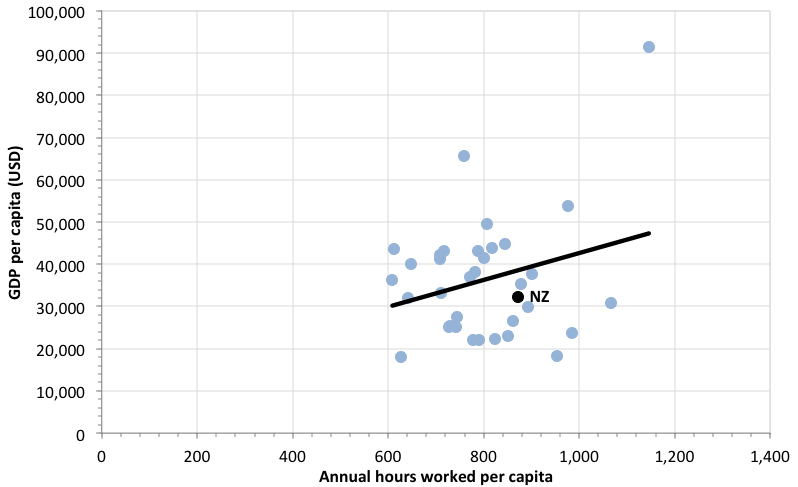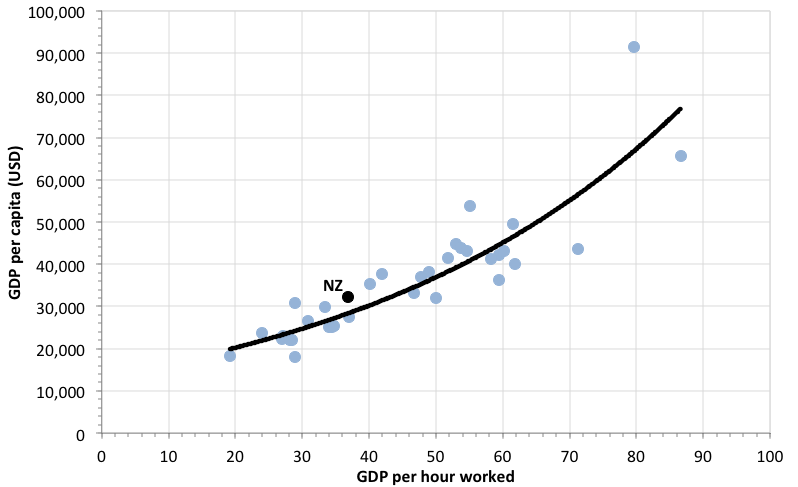A recent paper1 by the Productivity Commission has shone a lot of light on New Zealand’s productivity performance. After considering a variety of possible explanations, the Commission’s analysis shows that a long slow decline of New Zealand’s labour productivity is the main reason why growth of GDP per capita in New Zealand has not kept pace with other OECD countries. Even more worryingly, the paper shows that productivity in New Zealand is not catching up with other countries.
New Zealanders work relatively hard – an average of 871 hours per person in 2012, on a par with Japan (878 hours) and Israel (892 hours), and 9% more than the OECD average of 802 hours. Only eight of 34 other countries in the OECD worked more hours per person than New Zealand in 2012.
Unfortunately, hard work on its own doesn’t seem to be a good way to increase incomes. The following chart shows GDP per capita in OECD countries in 2012 versus annual hours worked per person. Working harder increases incomes somewhat, but hours worked only explains 7.5% of the variation in GDP per capita across countries. If New Zealanders worked as hard as Koreans (1,067 hours per year), we’d increase our per capita GDP by 22%, but we’d still be 12% behind Australia due to our low productivity.
Productivity does a much better job of explaining the difference in GDP per capita across countries, as shown in the following chart, again for OECD countries in 2012. Differences in productivity (measured as GDP per hour worked) explain 84% of the variation in GDP per capita.
It’s clear from the two charts above that the only way for New Zealand to significantly increase GDP per capita is to improve productivity. If we could improve our productivity from its current level to the OECD average and worked as hard as we do now, our per capita income would be 23% higher. If we could make it to the upper quartile of OECD productivity, our per capita incomes would be 54% greater than now.
Alternatively, if you’d prefer more leisure time, matching the productivity of the Spanish would allow us to work 230 fewer hours per person per year and have exactly the same per capita GDP as we do now – that’s an extra four and a half hours of free time every week for everyone.
So the key questions are why New Zealand’s productivity performance is so poor, and what can be done about it. Answering these questions requires diving deeper into the structure of New Zealand’s economy.
Roger Procter, Chief Economist of Ministry of Business, Innovation, and Employment, has done some preliminary analysis of productivity at the level of individual firms,2 and found that while some New Zealand firms have very high productivity, there seems to be a very long tail of low productivity firms that are able to survive.
Roger’s analysis indicates that the ratio of productivity of the firm at the 90th percentile (ie near the top) to the 10th percentile (bottom) of the productivity distribution in New Zealand industries is around nine. In other words, a New Zealand firm that is nine times less productive than the best firms in the same industry is able to survive.
In contrast, Roger reports evidence that the same ratio in Denmark is around 1.6 to 3.5. Danish firms that can’t achieve at least a quarter of the productivity of the best firms in the same industry get killed off by the forces of competition. Perhaps it’s no surprise then that Denmark’s productivity is 61% higher than New Zealand, and although the Danish work 19% fewer hours per person than New Zealanders, their per-capita GDP is 31% higher than ours.
Roger argues, and I agree, that a lack of competition in New Zealand markets is an important reason for this. Competition forces firms to increase productivity and kills off those that don’t. He also points to New Zealand’s relatively low level of international trade, as trade is a good substitute for local competition, especially for a small economy. Again I agree, but while exports are often the focus of political interest in trade, I’d argue that there should be plenty of emphasis on imports as well.
To see why, imagine you are running a New Zealand firm in the bottom half of the productivity distribution. You are surviving and probably comfortable, perhaps not facing much domestic competition. If you started exporting to a country like Denmark, you’d have to compete with considerably more productive firms based there. Unless you were really motivated to improve your performance, you probably wouldn’t be keen on exporting and would just keep serving the New Zealand market.
This might also explain why New Zealand doesn’t trade very much. We could be stuck in a low-competition, low-productivity, low-trade equilibrium. New Zealand domestic markets are too small to support enough intense competition to get us out of this state, and not enough firms are motivated by the prospect of export sales to drag the economy up the productivity mountain.
On the other hand, if low cost imports from productive foreign firms start coming in, unproductive firms will be forced to improve their game. I realise this is a harsh stick, rather than an export carrot. Exports create jobs and imports can destroy them, at least temporarily, and some employees might need assistance during the transition. But given New Zealand’s dire productivity statistics, maybe a strong shock to the system is required.
- Paul Conway and Lisa Meehan, Productivity by the numbers: The New Zealand Experience, New Zealand Productivity Commission Research Paper, September 2013, available at http://www.productivity.govt.nz/research-paper/productivity-by-the-numbers-the-new-zealand-experience. ↩
- Roger Procter, Unpicking New Zealand’s Productivity Paradox, presentation to the New Zealand Productivity Commission symposium, July 2013, available at http://www.productivity.govt.nz/sites/default/files/symposium-ppt-02_b_procter_causes.pdf. ↩



